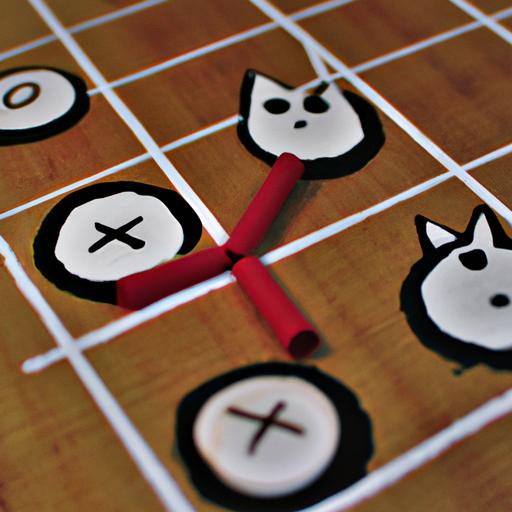Why is it Called a Cat’s Game?

Have you ever wondered why a tied game is often referred to as a “cat’s game”? This intriguing phrase has made its way into popular culture, particularly in the realm of gaming. Let’s dive into the origins of this term and explore its significance.
Definition of a “Cat’s Game”
A “cat’s game” refers to a game where neither player emerges as the winner, resulting in a draw or a tie. This expression is commonly used in various competitive activities, including board games, sports, and even video games. The phrase has gained traction for its unique and catchy nature, capturing the essence of a stalemate situation.
The Origin Story
While the exact origin of the term remains somewhat elusive, it is believed to have emerged in the early 19th century. The phrase “cat’s game” is thought to have its roots in the game of tic-tac-toe, also known as noughts and crosses. In this classic game, if neither player achieves a winning combination, the outcome is a draw. The phrase “cat’s game” was likely born from the notion that cats are known for their agility and ability to outmaneuver their opponents, yet even they can’t secure a victory in this particular game.
Throughout history, the term “cat’s game” has permeated various forms of entertainment and leisure activities. Its popularity can be attributed to its simplicity and relatability. Whether you’re engaged in a heated chess match or battling it out in a virtual world, encountering a “cat’s game” can evoke a sense of frustration, but also a shared understanding of the competitive nature of the game.
In the next section, we’ll delve deeper into the historical background of the phrase, exploring its evolution and contextual significance. Stay tuned to uncover more about this intriguing expression and why it continues to captivate our interest.
Historical Background of the Phrase

Tracing the Origins of the Expression “Cat’s Game”
The origins of the term “cat’s game” can be traced back to the 19th century, where it gained prominence in the game of tic-tac-toe. This classic game, played on a grid of nine squares, requires players to strategically place X’s and O’s to form a winning combination. However, when neither player achieves a winning sequence, the result is a draw, often referred to as a “cat’s game.”
Historical References to the Term in Various Contexts
Over time, the term “cat’s game” has transcended the boundaries of tic-tac-toe and has found its way into various contexts. It has been used in different games, such as chess, checkers, and card games, to describe a situation where neither player can secure a victory. Outside of the gaming realm, the expression has been adopted in sports, politics, and even economics, signifying a deadlock or a situation where neither party emerges as the clear winner.
Evolution of the Term’s Usage in Relation to Games
The usage of the term “cat’s game” has evolved alongside the development of games and the expansion of popular culture. As games have progressed and diversified, the phrase has been applied to various scenarios where a tie or a draw occurs. From traditional board games to modern virtual gaming experiences, encountering a “cat’s game” has become a common occurrence across different platforms.
The term’s enduring popularity can be attributed to its simplicity and universal understanding. It encapsulates the frustration and anticipation that comes with reaching a stalemate, while also serving as a reminder of the inherent unpredictability and competitiveness of games. In the next section, we will delve into the concept of a “cat’s game” in different gaming scenarios, exploring its symbolic meaning and cultural significance. Join me as we uncover more about this intriguing expression and its implications in the world of games.
Explanation of the Term in Gaming

Introduction to the Concept of a “Cat’s Game” in Different Games
The concept of a “cat’s game” extends beyond tic-tac-toe and finds its place in various other games. From strategic board games like chess to intense card games such as poker, the term is often used to describe a deadlock where neither player emerges victorious. This can occur due to evenly matched skills, defensive playstyles, or unforeseen circumstances that prevent a conclusive outcome.
Common Instances Where the Term is Used
In addition to tic-tac-toe, “cat’s game” is frequently employed in other popular games. For instance, in chess, it refers to a situation where the game ends in a draw due to insufficient material to force a checkmate. Similarly, in card games like blackjack, a “push” occurs when both the player and the dealer have the same total, resulting in a tie.
Sports also have their fair share of “cat’s game” scenarios. In football, a tie game where neither team scores is often considered a “cat’s game.” Similarly, in basketball, if teams are tied at the end of regulation time and neither gains an advantage in overtime, it can be referred to as a “cat’s game.”
How the Term is Applied in Specific Games, such as Tic-Tac-Toe
Tic-tac-toe, also known as noughts and crosses, is a classic game that perfectly exemplifies the concept of a “cat’s game.” Played on a grid of nine squares, players take turns placing their symbol (X or O) in an attempt to create a winning line. However, if the game progresses without either player achieving a winning combination, it results in a “cat’s game” or a draw.
The term’s association with tic-tac-toe has solidified its place in gaming vocabulary, making it a widely recognized expression. Its simplicity and relatability have allowed it to transcend tic-tac-toe and become a metaphor for any game that ends without a clear winner.
In the upcoming sections, we’ll explore the symbolic meaning behind the term “cat’s game” and its portrayal in literature and media. Join me as we unravel the layers of significance hidden within this intriguing expression.
Understanding the Symbolic Meaning
Analyzing the Symbolic Meaning behind “Cat’s Game”
The term “cat’s game” carries a symbolic meaning that extends beyond its literal interpretation. In the realm of gaming, it represents more than just a tie or a draw. Metaphorically, it embodies the notion of a fierce competition where both players exhibit skill and strategy, yet ultimately reach a stalemate. This symbolic meaning resonates with our experiences in life, where we often encounter situations that result in a deadlock despite our best efforts.
Interpretation of the Term in Relation to Game Outcomes
When we delve deeper into the interpretation of a “cat’s game,” we uncover the concept of balance and equilibrium. It symbolizes a harmonious clash of skills, where neither player dominates the other. This interpretation highlights the idea that success is not solely defined by victory but can also be found in the pursuit of excellence and the ability to challenge oneself.
Furthermore, a “cat’s game” reminds us that sometimes the journey is just as important as the destination. The intense competition and strategic maneuvers leading up to the tie can be immensely rewarding, fostering personal growth and sharpening our abilities. It encourages us to appreciate the process rather than being solely fixated on the outcome.
Cultural Significance and its Portrayal in Literature and Media
The cultural significance of a “cat’s game” is evident in its portrayal across various forms of art and media. In literature, this term often appears as a metaphor for the unpredictability of life and the inherent uncertainty we face. It serves as a reminder that not all battles can be won and that accepting a draw can be an honorable outcome.
Moreover, in movies and television shows, the concept of a “cat’s game” is frequently employed to heighten suspense and create dramatic tension. It adds complexity to the storyline, leaving audiences on the edge of their seats as they witness the unfolding of a gripping competition that ultimately ends in a draw.
In conclusion, the symbolic meaning behind “cat’s game” goes beyond the realm of gaming. It reflects the balance between skill and strategy, the significance of the journey, and the acceptance of uncertainty. Its portrayal in literature and media further emphasizes its cultural significance. As we explore the next section, we’ll shed light on the reasons behind using the term “cat’s game” and its psychological impact on players.
Conclusion
In conclusion, the term “cat’s game” has solidified its place in popular culture, particularly in the realm of gaming. We have explored the origins of this expression, tracing it back to the game of tic-tac-toe and understanding its relevance in various competitive activities.
The unique charm of “cat’s game” lies in its simplicity and relatability. It encapsulates the frustration of a tied game, where neither player emerges as the victor. This term has found its way into literature, media, and everyday conversations, resonating with individuals who have experienced the thrill and disappointment of a draw.
Throughout our journey, we have discovered that the use of “cat’s game” goes beyond mere description. It also carries psychological implications, impacting players’ mindset and approach to gameplay. The realization that victory is out of reach can either ignite a fierce determination to break the stalemate or lead to a sense of resignation.
While alternative terms exist to describe a tied game, none quite capture the essence and cultural significance of “cat’s game.” It has become a symbol of equilibrium, reminding us that even the most skilled competitors can be evenly matched. The term has woven its way into our collective consciousness, acting as a reminder of the unpredictability and excitement that games offer.
As we wrap up our exploration of “cat’s game,” let us embrace the beauty of competition and the thrill of a close match. Whether we find ourselves in a board game marathon or battling it out in the virtual realm, let the term “cat’s game” serve as a reminder of the joy and camaraderie that can be found in the quest for victory.
Thank you for joining me on this journey. Remember to check out Game Hoy for more captivating articles and insights on the fascinating world of games. Stay tuned for more engaging content and happy gaming!
Conclusion: So above is the Why is it Called a Cat’s Game? article. Hopefully with this article you can help you in life, always follow and read our good articles on the website: Game Hoy




